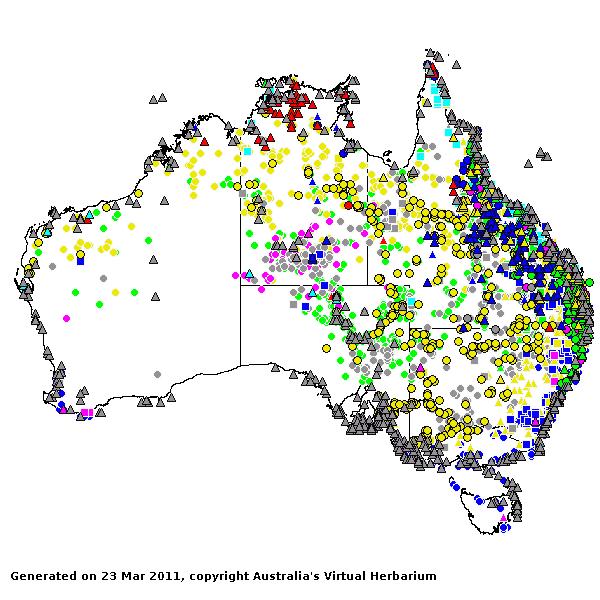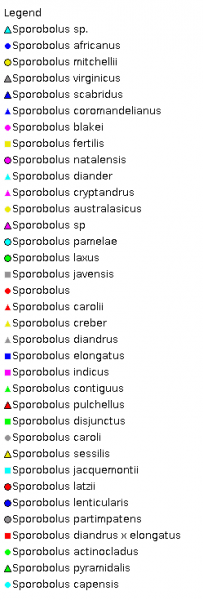Sporobolus Prodr. 169 (1810).
Derivation:. From Greek sporos (seed) and bolos (throwing), alluding to the ease of dispersal of the seed.
Taxonomic revisions, nomenclatural references:. B.K.Simon, Austrobaileya 1: 459–460 (1982); G.F.Baaijens & J.F.Veldkamp, Blumea 35: 393–458 (1991); B.K.Simon, Austrobaileya 4: 669–681 (1993); B.K.Simon and S.W.L.Jacobs, Aust. Syst. Bot. 12: 375–448 (1999).
Key references (keys and floras):. G.Bentham, Flora Australiensis 7: 620–624 (1878); C.A.Gardner, Flora of Western Australia 1 Gramineae 159–163 (1952); E.E.Henty, Manual Grasses New Guinea 180–181 (1969); M.Lazarides, Tropical Grasses S.E.Asia 190–192 (1980); M.Lazarides, Flora of Central Australia 467–469 (1981); B.K.Simon, Aust. Syst. Bot. Newsletter 31: 16–19 (1982); J.C.Tothill and J.B.Hacker, Grasses of Southern Queensland 386–389 (1983); J.P.Jessop, Flora of South Australia 4: 1955–1957 (1986); M.Lazarides, F.Quinn and J.Palmer, Flora of the Kimberley Region 1222–1225 (1992); B.K.Simon, Key to Australian Grasses 160–162 (1993); S.W.L.Jacobs and K.L.McClay, Flora of New South Wales 4: 523–527 (1993); N.G.Walsh, Flora of Victoria 2: 615–616 (1994); D.I.Morris, Student's Flora of Tasmania 4B: 327–329 (1994); E.Edgar and H.E.Connor, Flora of New Zealand 5: 530–533 (2000); D.Sharp and B.K.Simon, AusGrass (2002); K.Mallet (ed.), Flora of Australia 44B: Poaceae 3: 324–346 (2005); J.P.Jessop, Grasses of South Australia 395–401 (2006); S.W.L.Jacobs, R.D.B.Whalley & D.J.B.Wheeler, Grasses of New South Wales, 4th ed, 374–380 (2008).
W.D.Clayton & S.A.Renvoize, Genera Graminum (1986), genus (377).
Native and naturalised. About 160 species, from tropical and warm temperate regions. 24 species in Australia, WA, NT, SA, Qld, NSW, Vic, and Tas. Also New Guinea, Malesia and New Zealand.
Habit. Annual (rarely) or perennial, rhizomatous or stoloniferous or tufted or decumbent. Leaf blades narrow. Ligule a fringed membrane (narrow) or a fringe of hairs.
Inflorescence. Inflorescence a false spike, with spikelets on contracted axes (rarely) or a single raceme (rarely) or paniculate, a spike-like panicle or an open panicle with branches ending in single spikelets, open to contracted (rarely with the lowest branches sterile).
Spikelets. Spikelets laterally compressed to subterete, 1 flowered, with 1 fertile floret, solitary, subsessile or pedicelled; with naked rachilla extension, or with rachilla terminating in a floret. Fertile spikelets often fusiform, disarticulating above glumes.
Glumes. Glumes unequal (lower glume often very short) or more or less equal, shorter than adjacent lemmas or long relative to adjacent lemmas, hairless, glabrous, awnless (occasionally mucronate), keeled (slightly) or non-keeled (convex), dissimilar to similar (persistent or subpersistent, thinly membranous or hyaline, the upper usually resembling the lemma). Lower glume 1 nerved. Upper glume 1 nerved.
Florets. Fertile florets 1. Lemmas usually thinly membranous, rarely papery, not becoming indurated, entire at apex, pointed or blunt, muticous, 1(–3) nerved, glabrous, 1 keeled to not keeled. Palea relatively long, entire or apically notched or deeply bifid (often splitting as the grain develops), textured like lemma (delicate), 2 nerved. Callus absent or short, (when present) blunt. Lodicules when present 2. Stamens (1–)2–3. Grain small, compressed laterally or compressed dorsiventrally or terete (variously globular or compressed). Hilum short. Embryo large.
Kranz Anatomy. C4, biochemical type PCK (6 species) or NAD-ME (4 species).
2n = 18, 24, 36, 38, 54, 72, 80, 88, 90, 108, and 126, 2, 4, 6, 8, 9, 10, 12, and 13 ploid, commonly adventive.
Habitat. Mesophytic, xerophytic. In diverse habitats, including coastal sand dunes.
Classification. Chloridoideae; Cynodonteae.
Notes. The genus may be roughly partitioned according to whether the inflorescence branches are whorled or not, but formal subdivisions seem impractical. In fact the species intergrade to such an extent that their limits are seldom sharply defined, and they somtimes seem to take the form of noda in a continuum of variation. It is distinguished from Eragrostis by its 1-flowered spikelets and 1-nerved lemmas, but the boundary between the genera is blurred by a number of intermediates which have been arbitrarily assigned to Eragrostis on account of their 2-flowered spikelets. The mucilaginous pericarp is characteristic, but by no means diagnostic (Clayton and Renvoize, 1986).
Types Species. S. indicus (L.) R.Br.
Biogeographic Element. Clifford & Simon 1981, Simon & Jacobs 1990: Gondwanan.


